2014 PEUGEOT 108 engine oil
[x] Cancel search: engine oilPage 11 of 256
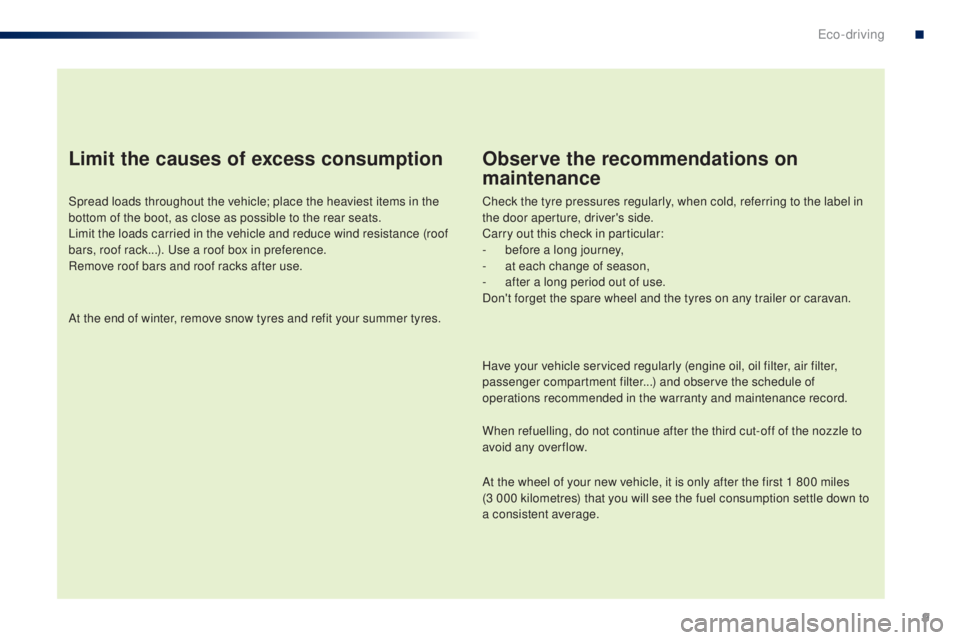
9
Limit the causes of excess consumption
Spread loads throughout the vehicle; place the heaviest items in the
bottom of the boot, as close as possible to the rear seats.
Limit the loads carried in the vehicle and reduce wind resistance (roof
bars, roof rack...). u
s
e a roof box in preference.
Remove roof bars and roof racks after use.
At the end of winter, remove snow tyres and refit your summer tyres.
Observe the recommendations on
maintenance
Check the tyre pressures regularly, when cold, referring to the label in
the door aperture, driver's side.
Carry out this check in particular:
-
b
efore a long journey,
-
a
t each change of season,
-
a
fter a long period out of use.
Don't forget the spare wheel and the tyres on any trailer or caravan.
Have your vehicle serviced regularly (engine oil, oil filter, air filter,
passenger compartment filter...) and observe the schedule of
operations recommended in the warranty and maintenance record.
When refuelling, do not continue after the third cut-off of the nozzle to
avoid any over flow.
At the wheel of your new vehicle, it is only after the first 1 800 miles
(3
000 kilometres) that you will see the fuel consumption settle down to
a consistent average.
.
Eco-driving
Page 21 of 256

19
Brakingfixed.th e braking system fluid level has
dropped significantly.to p up with brake fluid recommended by Pe ugeOt.
I f the problem persists, have the system checked by a
P
e
uge
Ot
dealer or a qualified workshop.
th
e braking system has a fault. Stop as soon as it is safe to do so.Park, switch off the ignition and contact a P
e
uge
Ot
dealer or a qualified workshop.
Warning / indicator lamp
StateCause Action / Observations
Warning lamps
STOPflashing, associated
with another warning
lamp. It is associated with the engine
oil pressure or the engine coolant
temperature. Stop as soon as it is safe to do so.
Park, switch off the ignition and call a Pe
ugeOt
dealer or qualified workshop.
When the engine is running or the vehicle is being driven, illumination of one of the following warning lamps indicates a fault which requires action on
the part of the driver.
Any fault resulting in the illumination of a warning lamp must be investigated further.
If you encounter any problems, do not hesitate to contact a P
e
uge
Ot
dealer or a qualified workshop.
Engine oil
pressure fixed, associated with
the S
tO
P warning
lamp.
th
e engine oil pressure is too low. Stop as soon it is safe to do so.Park, switch off the ignition and contact a P
e
uge
Ot
dealer or a qualified workshop.
1
Monitoring
Page 173 of 256
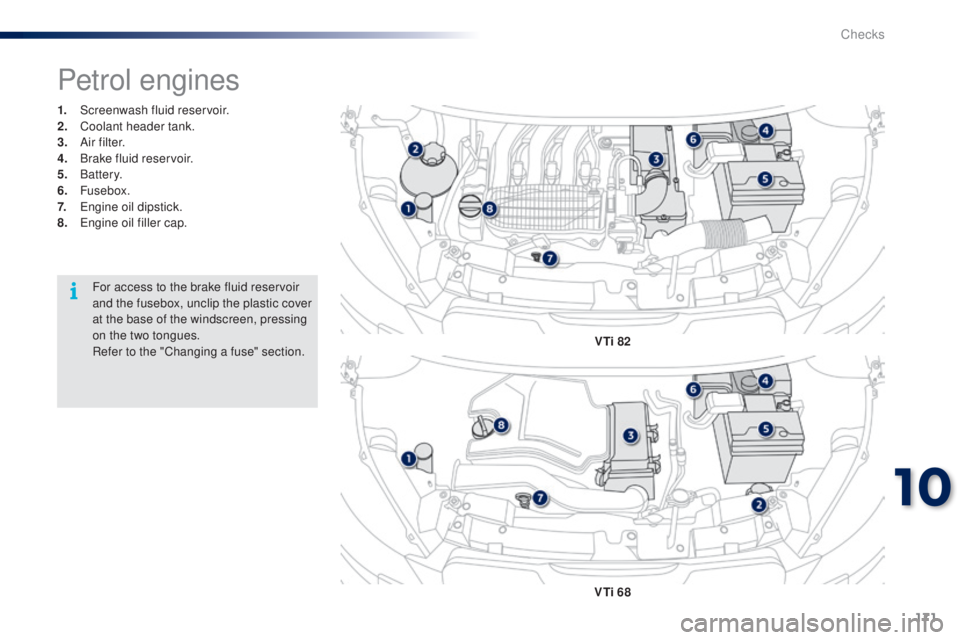
171
1. Screenwash fluid reservoir.
2. Coolant header tank.
3.
A
i r f i l t e r.
4.
B
rake fluid reservoir.
5.
Battery.
6.
Fusebox.
7.
e
n
gine oil dipstick.
8.
e
n
gine oil filler cap.
Petrol engines
VTi 82
VTi 68
For access to the brake fluid reservoir
and the fusebox, unclip the plastic cover
at the base of the windscreen, pressing
on the two tongues.
Refer to the "Changing a fuse" section.
10
Checks
Page 174 of 256
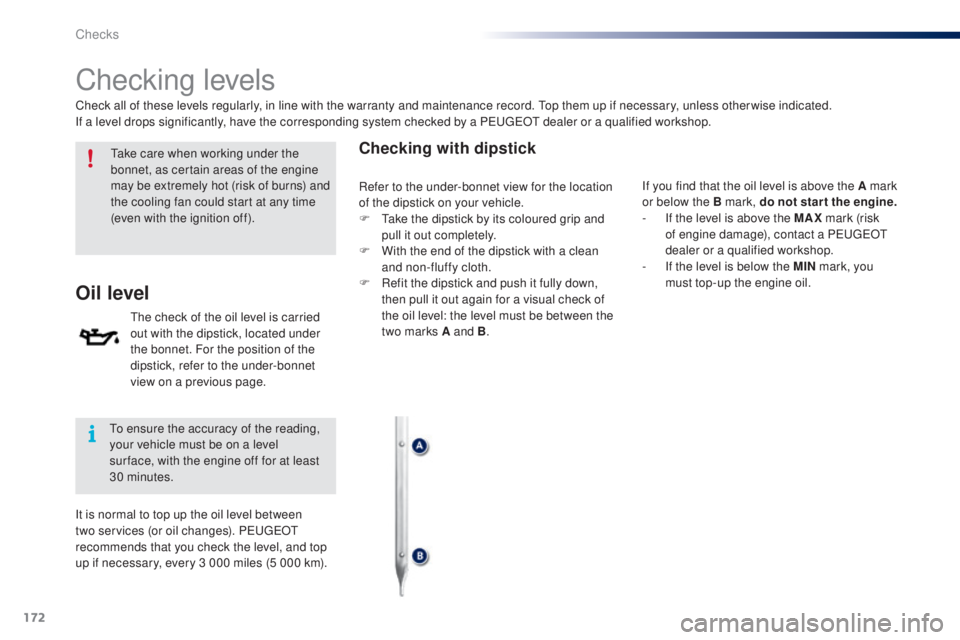
172
Checking levels
take care when working under the
bonnet, as certain areas of the engine
may be extremely hot (risk of burns) and
the cooling fan could start at any time
(even with the ignition off).
Oil level
the check of the oil level is carried
out with the dipstick, located under
the bonnet. For the position of the
dipstick, refer to the under-bonnet
view on a previous page.
Checking with dipstick
Check all of these levels regularly, in line with the warranty and maintenance record. top them up if necessary, unless other wise indicated.
If a level drops significantly, have the corresponding system checked by a Pe ugeOt dealer or a qualified workshop.
to e
nsure the accuracy of the reading,
your vehicle must be on a level
sur face, with the engine off for at least
30
minutes.
It is normal to top up the oil level between
two services (or oil changes). P
e
uge
Ot
recommends that you check the level, and top
up if necessary, every 3 000 miles (5 000 km). If you find that the oil level is above the A mark
or below the B mark, do not star t the engine.
-
I
f the level is above the MAX mark (risk
of engine damage), contact a P
e
uge
Ot
dealer or a qualified workshop.
-
I
f the level is below the MIN mark, you
must top-up the engine oil.
Refer to the under-bonnet view for the location
of the dipstick on your vehicle.
F
t
a
ke the dipstick by its coloured grip and
pull it out completely.
F
W
ith the end of the dipstick with a clean
and non-fluffy cloth.
F
R
efit the dipstick and push it fully down,
then pull it out again for a visual check of
the oil level: the level must be between the
two marks A and B .
Checks
Page 175 of 256
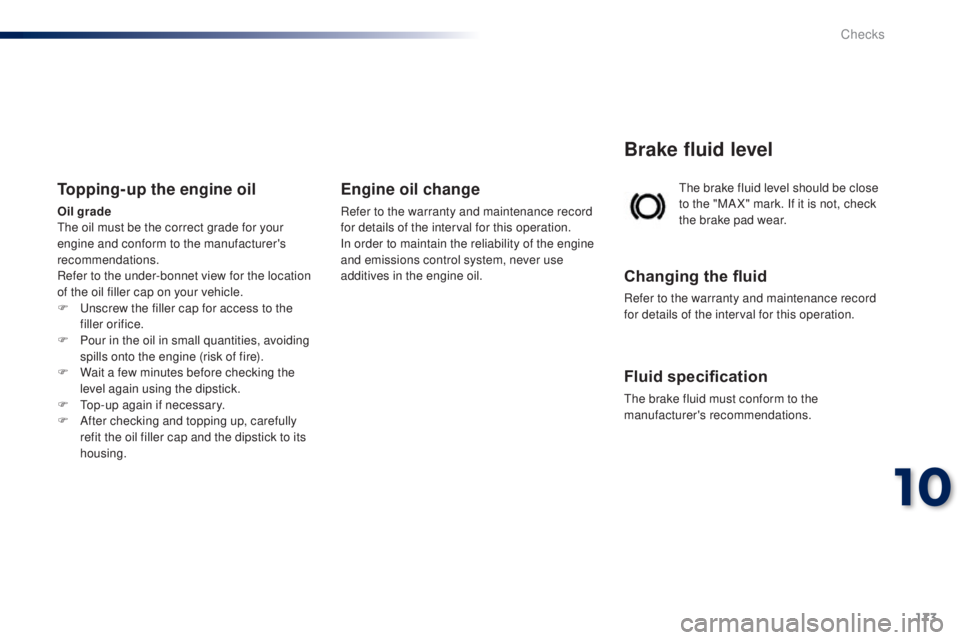
173
the brake fluid level should be close
to the "MA X" mark. If it is not, check
the brake pad wear.
Brake fluid level
Changing the fluid
Refer to the warranty and maintenance record
for details of the interval for this operation.
Fluid specification
the brake fluid must conform to the
manufacturer's recommendations.
Topping-up the engine oil
Oil gradethe oil must be the correct grade for your
engine and conform to the manufacturer's
recommendations.
Refer to the under-bonnet view for the location
of the oil filler cap on your vehicle.
F
u
n
screw the filler cap for access to the
filler orifice.
F
P
our in the oil in small quantities, avoiding
spills onto the engine (risk of fire).
F
W
ait a few minutes before checking the
level again using the dipstick.
F
t
o
p-up again if necessary.
F
A
fter checking and topping up, carefully
refit the oil filler cap and the dipstick to its
housing.
Engine oil change
Refer to the warranty and maintenance record
for details of the interval for this operation.
In order to maintain the reliability of the engine
and emissions control system, never use
additives in the engine oil.
10
Checks
Page 176 of 256

174
Avoid prolonged contact of used oil or
fluids with the skin.
Most of these fluids are harmful to
health or indeed very corrosive.
Do not discard used oil or fluids into
sewers or onto the ground.
ta
ke used oil to a P
e
uge
Ot
dealer or
a qualified workshop (France) or to an
authorised waste disposal site.
Used products
Fluid specification
For optimum cleaning and to avoid freezing,
this fluid must not be topped up or replaced
with plain water.
In wintry conditions, it is recommended that you
use an ethyl alcohol or methanol based fluid.
Screenwash fluid level
top up the level when necessary.
Coolant level
the coolant level must be:
- b etween the " FULL" or "F" and
" LOW " or "L" marks for V
ti 6
8
and e-V
ti 6
8 engines,
In addition, as the cooling system is pressurised,
wait at least one hour after switching off the
engine before carrying out any work.
to a
void any risk of scalding, unscrew the cap
by two turns to allow the pressure to drop.
When the pressure has dropped, remove the
cap and top up the level.
Fluid specification
the coolant must conform to the
manufacturer's recommendations. The cooling fan may star t after switching
off the engine: take care with ar ticles and
clothing that might be caught by the fan
blades. -
b
etween the "
MIN" and " MAX" marks for
the V
ti 8
2 engine.
When the engine is warm, the temperature of
the coolant is regulated by the fan.
Checks
Page 177 of 256
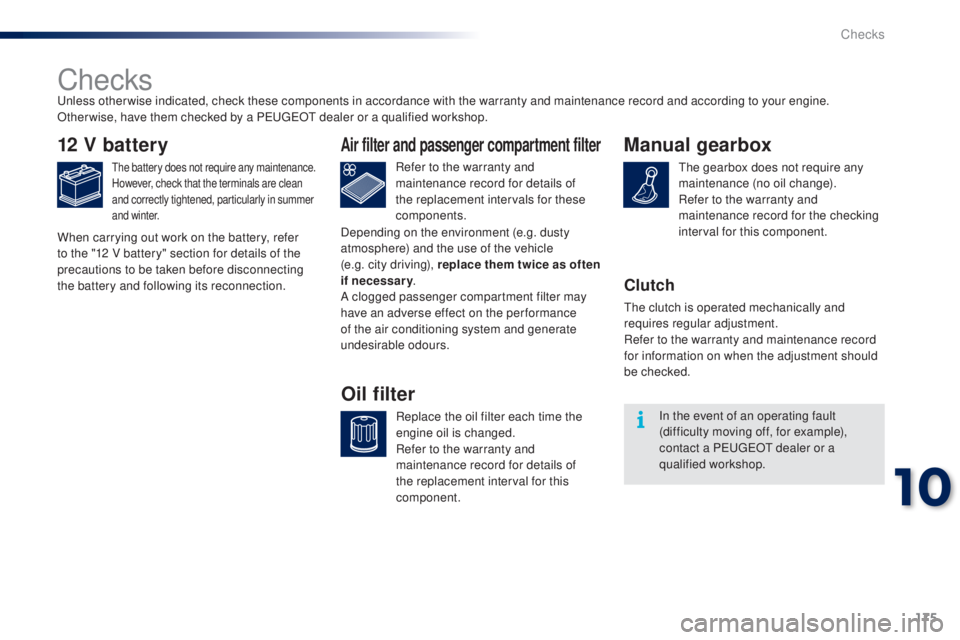
175
Checks
12 V battery
the battery does not require any maintenance.
However, check that the terminals are clean
and correctly tightened, particularly in summer
and winter.Refer to the warranty and
maintenance record for details of
the replacement intervals for these
components.
Air filter and passenger compartment filter
Replace the oil filter each time the
engine oil is changed.
Refer to the warranty and
maintenance record for details of
the replacement interval for this
component.
Oil filter
unless other wise indicated, check these components in accordance with the warranty and maintenance record and according to your engine.
Other wise, have them checked by a PeugeOt dealer or a qualified workshop.
Depending on the environment (e.g. dusty
atmosphere) and the use of the vehicle
(e.g.
city driving), replace them twice as often
if necessary .
A clogged passenger compartment filter may
have an adverse effect on the per formance
of the air conditioning system and generate
undesirable odours.
When carrying out work on the battery, refer
to the "12 V battery" section for details of the
precautions to be taken before disconnecting
the battery and following its reconnection.
Manual gearbox
the gearbox does not require any
maintenance (no oil change).
Refer to the warranty and
maintenance record for the checking
interval for this component.
Clutch
the clutch is operated mechanically and
requires regular adjustment.
Refer to the warranty and maintenance record
for information on when the adjustment should
be checked.
In the event of an operating fault
(difficulty moving off, for example),
contact a P
e
uge
Ot
dealer or a
qualified workshop.
10
Checks
Page 179 of 256

177
Petrol engineVTi 68
e-VTi 68VTi 82
Manual gearbox
(5 - speed) ETG electronic
gearbox
(5 - speed) Manual gearbox
(5 - speed) Manual gearbox
(5 - speed)
Model codes PM, PN PSCFBB - B1A000
PSCFBB-H1A000
PSCFBB-P1A000
PSCFBB-W1A000 PSCFBB-B1C000
PSCFBB-H1C000 PSCFBB-P1C000
PSCFBB-W1C000 PSCFB2-B1B000
PSCFB2-H1B000 PSCFB2-P1B000
PSCFB2-W1B000 PAHMTB - B1A000
PAHMTB-H1A000 PAHMTB-P1A000
PAHMTB-W1A000
Cubic capacity (cc) 9989989981 19 9
Bore x stroke (mm) 71 x 8471 x 8471 x 8477 x 85.8
e
u standard maximum power (kW)* 50505060
Max power engine speed (rpm) 6 0006 0006 000 5 750
e
u standard max torque (Nm) 95.595.595.5 11 6
Max torque engine speed (rpm) 4 8004 8004 800 2 750
Fuel
u
nleaded petrol
u
nleaded petrol
u
nleaded petrol
Catalytic converter Ye sYe sYe s
en
gine oil capacity (with filter replacement) 3.23.23.23.25
*
t
h
e maximum power corresponds to the value type-approved on a test bed, under conditions defined in e
u
ropean legislation (Directive 1999/99/
eC
).
engines
11
Technical data